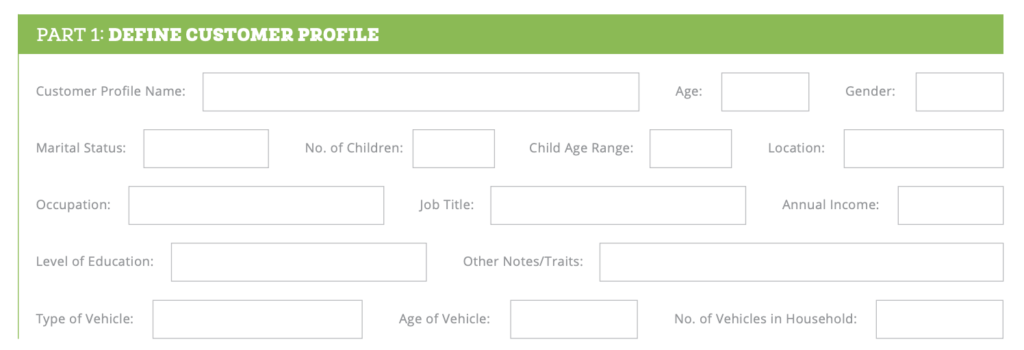The most successful auto repair shop owners have a clear idea who they’re targeting, what those audiences need to hear in order to convert, and when/where is the best time to target these people.
In other words — they’ve identified their ideal customer. That’s because you don’t know how to market your products and services until you know who you’re marketing to, and that’s a fundamental part of a complete marketing plan.
By who, we don’t mean generic classifications like men or women ages 18-45. Defining your ideal customer requires a deep dive into your business goals, your local market, the products/services you offer, and more. That’s why successful shop owners develop customer avatars (or buyer personas) for each of their key prospects.
These avatars help you understand the mindset, motivation, and behaviors of your customers — so you can market to them with tremendous success.
This guide will walk you through the steps of how to define — and develop — your customer avatars.
The Benefits of a Customer Avatar
Building your customer avatar is like developing a roadmap for your entire marketing strategy. Just consider some of the ways you likely do — or should — market your repair shop:
- Blogs/Content Marketing — A customer avatar helps you understand what kind of content potential customers want or need.
- Paid Ads (Facebook, Google) — You’ll know which channels your prospects spend the most time on — so you know which channels are worth investing in.
- Email Marketing — Your avatar will help you identify which emails should go out to specific customers, and when.
- Copywriting — What language should you use in ads, emails, and your website? What kind of tone? Your avatars will help you make a decision based on data.
- New Services — You’re always looking for new services to attract more customers. Developing avatars can help you identify which services your customers actually want — and need.
While developing customer avatars can take some time, the payoff is profound — and continuous. You’ll know how, when, and where to market to your customers. And you’ll know what types of products and services your shop should offer.
What to Include in Customer Avatars
In a moment we’ll provide an example avatar to help you visualize the process. But first — there are several different ways to approach customer avatars. For your purposes, our experience shows us that each of your customer avatars should include five distinct sections.
You can follow along by downloading our free avatar worksheet here.
Profile (or Demographic Information)

Your customers are people. People with names, families, jobs, incomes, and more. These aren’t arbitrary pieces of information. Think of it like this: a working single mother likely has very specific needs, vs. a man or woman who works from home, has no children and has a flexible schedule.
The age of a customer’s vehicle also greatly impacts their relationship with you.
Fleshing out the demographics of your customer avatars will bring these avatars to life — including naming each avatar. Rather than say “How will I target that group of single mothers”, you can say “How will I target Betty?”
Don’t underestimate how important it is to name your avatars. In fact, some shop owners use headshots, too.
Goals and Values

Goals and values are key factors in what your customers choose to buy, why they choose to buy it, and when.
- Customer goals identify what your customers want. Do they want convenience? Speed? Reliability?
- Customer values identify what’s most important to them. Do they want 100% transparency in the work you do? Do they value trusting their mechanic above all else — even if it means pricier service?
Many shop owners flesh out this section by using their best assumptions and guesses. There’s nothing wrong with this. You likely know your customers very well and are in an ideal position to understand their goals and values.
However, whenever possible, go straight to the source itself. Survey your customers to better understand what makes them tick.
Challenges and Pain Points

Marketing isn’t just about knowing who to target. It’s knowing how to craft an experience that drives your prospects into action.
You do this by homing in on your customers’ challenges and pain points.
Assumptions and personal experience can shape this section. But again, surveys can, too.
It’s important to use your customers’ language and mindset for this step. That’s because your marketing copy is far more effective if you use the same language and voice as your customers.
For example, our single working mother might identify one challenge as:
- I can’t afford not to have a car for hours at a time. I have work. Have to pick up the kids after school. Have soccer practice, dance class, and we usually go to the market to get stuff for dinner. Even 2 hours without a car at hand makes life impossible for me.
In the next section, we’ll show you how you can shape your marketing around this challenge.
Information Sources

You could have the best ad for your customers. But that ad is useless unless you know where to post it. Does your customer use Facebook? Instagram? Do they spend time on certain news sites? Do they use Google a lot? Do they follow certain influencers or attend specific conferences?
This is where the information sources section comes in — to fill in these gaps. The more you know of where your customers gather information, the better your marketing and targeting will be.
Here’s an incredibly important factor to consider for this section: Smaller is better. Meaning, the more specific you can be with information sources, the better. Knowing your customers are on FB or IG is great — but most of America is.
Knowing your customers follow a type of brand on FB or IG is far more powerful.
In other words, you want to find the niche information sources for your customers. To do this, follow the no one else would approach.
- {Customer Avatar #1} reads {book}, but no one else would.
- {Customer Avatar #1} subscribefs to {magazine}, but no one else would.
And so on.
Objections and Role in the Purchase

Every one of your potential — and current — customers are looking for reasons not to convert. It’s human nature. People are averse to spending their money.
One of your goals when marketing your auto repair shop is to address these obstacles head-on. By doing this, you make it increasingly difficult for prospects not to buy from you.
Keep in mind — each customer type will likely have different objections.
For example, our working mother might be concerned with the amount of time a service she’s looking to have done might take. When marketing to her, it’s worth addressing this head-on:
Can’t sit and wait in our Wi-Fi waiting room? No problem. We’ll drive you to your destination and can deliver your car to you when it’s ready.
It’s also important to know what role in the purchase decision your persona has. For example, is your customer avatar the one with the purse strings? Is your avatar the one most likely to decide whether a service is worth paying for or not?
Customer Avatar Example
Below we provide a completed version of the customer avatar worksheet, for example purposes.
Then we break down how that information would be useful to the owner of an auto repair shop.
Part 1: Define Customer Profile
- Customer Profile Name: Amy
- Age: 37
- Gender: Female
- Marital Status: Married
- No. of children: 3
- Child Age Range: 2, 4, 7
- Location: Metairie
- Occupation: Stay-at-home mom + part-time store clerk on nights and weekends
- Job Title: N/A
- Annual Income: Household is $60,000
- Level of Education: College graduate
- Other notes/traits: Rarely has two free hands. Always has someplace to go. Meaning visits to the shop are viewed as an inconvenience.
- Type of vehicle: 2016 Toyota Sienna
- Age of vehicle: 3 years
- No. of vehicles in the household: 2
Once you’ve defined your avatar, many marketers take it a step further by finding a photo that represents the avatar.
For added benefit, here’s a photo of Amy:

How this information is useful:
- We know that Amy has young children, two of whom are likely with her all day (they’re not in school), the other which might be at school (meaning she likely has to drop off and pick up that child from school in mornings and afternoons).
- We can make sure she knows we have flexible hours.
- A good tactic might be to let her know VIP members get up to $20 credit in Uber or Lyft trips every 3 months. To become a VIP, customers simply have to join your mailing list.
- We also know that she needs her car at night and at weekends to get to work.
- Let her know we work around her schedule.
- Finally, we know that with 3 kids and a household income of $60,000, she does not have a lot of free cash to spend. You can use this to build trust with Amy.
- When creating your marketing materials, focus on must-have services — and make it clear that you aren’t wasting Amy’s time with ‘nice-to-have’ add-ons. You value her time too much.
- If you plan on using social media ads — this information is incredibly valuable. Facebook, for example, lets you target audiences based on demographic information and interests.
Part 2: Define Customer Goals & Values
- Customer Goals (What do they want?): Amy wants to get trusted service — fast.
- Customer Values (What’s important to them?): Trust and ease. A trip to the repair shop shouldn’t stress her out any more than she is.
How this information is useful:
- This is a key part of shaping your marketing message. Words like ‘trust’ and ‘simple’ will attract Amy. As will testimonials from customers who double down on how trustworthy you are — and how easy it is to get their car serviced at your shop.
Part 3: Identify Challenges & Pain Points
- Challenges: Needing somewhere to go with her kids while the car is being serviced. Either a kid-friendly place or the ability to go do errands.
- Pain Points: Amy is always in ‘mom’ mode. Answering questions, juggling the demands of her kids. She really just wants someone to take the wheel at the repair shop so she doesn’t have to manage one more thing.
How this information is useful:
- In email copy, social media, and blog posts you can write about how you have a kid-friendly (and safe) waiting room. Plus, you can show empathy toward moms like Amy. Use messaging like: “As a mom, you already have enough going on in your life. With us, servicing your car will be the easiest — and most stress-free — thing you do all day.”
Part 4: What Are Their Information Sources?
- The local newspaper (website)
- Neighborhood Facebook Groups
How this information is useful:
- You can advertise on these sites. But also, with places like Facebook Groups, you can monitor conversations and contribute as a member. Just don’t blatantly advertise your services. Be useful, not salesly.
Part 5: Define Objections & Role in Purchase
- Objections to the sale: Price and inconvenience (long wait time for service)
- Role in purchase process: Amy is a primary decision maker in her house. However, when it comes to car repairs, she likes to discuss with her husband first. Mostly because he has a mild understanding of auto mechanics and can assess if she’s being taken advantage of.
How this information is useful:
- In marketing copy, you can discuss how you price-match any other mechanic in town. Plus, you can talk about your fast service times and convenient (kid-friendly) waiting room.
- You can also discuss how you can text or email customers a rundown of the service you propose — making it easy for Amy to share that information with her husband from the convenience of their home.
We’ve only scratched the surface of what is possible with this example avatar. And keep in mind — this is just one example. We recommend most auto repair shops develop — at a minimum — three different avatars.
But don’t create too many avatars — that merely complicates your marketing efforts. Identify the most common — and diverse — customer segments your shop sees on a regular basis. Typically this will include, at a minimum, one male and female avatar.
Here’s that free Customer Avatar Worksheet again. Let us know if you need help fleshing it out — or using that information to grow your auto shop faster and more efficiently.

About The Author


